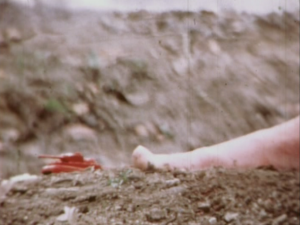
" La segunda primera matriz narraba visual y poéticamente una historia de la humanidad, desde el origen hasta la carrera espacial, como una nueva frontera. En una primera sección, entre tomas de nubes, remolinos y oscuridad, hacía referencia al origen de la vida. (...) Después del lanzamiento del cohete y de las imágenes sobre la exploración del espacio, se ve a una mujer desnuda en el campo. La cámara hace un lento tilt down recorriendo su cuerpo. Al pasar por el pubis sigue a una gota de sangre que comienza a deslizarse por la pierna. Cuando llega al suelo aparece un desfile de tanques de guerra en miniatura, rojos, como los que se habían mostrado anteriormente en la película. La película termina con un cartel que dice 'Pero también se puede parir la nada' " (Vázquez Mantecón, 2012).
La segunda primera matriz [The second first womb] told visually and poetically a story about humanity, from its origin to the Space Race, as a new frontier. In a first section, amongst shots of clouds, swirls and darkness, it referred to the origin of life. (...) After the launch of a rocket and images about exploring space, the film shows a woman naked in the country. The camera makes a slow tilt down of her body. When passing by the pubis, the camera follows a drop of blood that slides by the leg. When it reaches the floor, a parade of miniature war tanks appear, red, like the ones previously shown. The film ends with a sign that says 'But you can also give birth to nothing' " (Vázquez Mantecón, 2012).
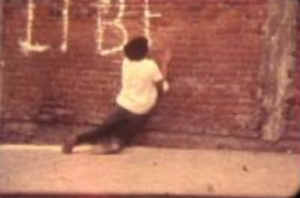
"El relato iniciaba con la presentación de un grupo de jóvenes que corren de manera desesperada por las calles de la ciudad, presumiblemente perseguidos por la policía. Inexplicablemente, dada la urgencia de la huída, uno se detiene a escribir en una barda la palabra "Libertad". No lo consigue, porque una bala lo derrumba cuando apenas va en "Libe...". (de ahí el título de la película). [...] La película apenas muestra una esperanza posible en la lucha por la libertad. Después del acoso y el acecho, todos los jóvenes que han protagonizado la historia mueren por una bala anónima de una fuerza represiva que no alcanza a tener un rostro definido" (Vázquez Mantecón, 2012).
"The story began with the presentation of a group of young people that run desperately throughout the city streets, presumably they are being chased by the police. Inexplicably, given the urgency of the escape, one of them stops to write the word "Freedom" on a wall. He fails, because a bullet overthrows him when he has barely written "Freed.." (hence the title of the film). [...] The film barely shows hope for the struggle for freedom. After the harassment and the siege, all the young people that starred the film are murdered by an anonymous bullet of a repressive force that does not have a defined face" (Vázquez Mantecón, 2012).
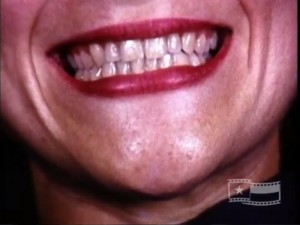
"Produced by Bea McKinney, “A Sexual Product” is a short amateur film featuring stop-motion animation. McKinney, who taught filmmaking at King High School in Corpus Christi, made the film while studying at the Center for Understanding Media in New York in July 1972" Texas Archive of the Moving Image.
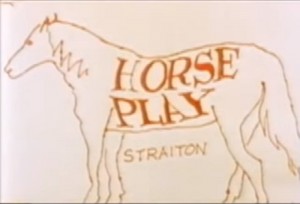
"A half-horse, half-man pursues a young woman who turns herself into the same figure. Using a spare animation style, Straiton deals with a mythological subject that reveals his personal sense of humour. A beautiful film, set to original music, that is stunning in its simplicity." Canadian Filmmakers Distribution Centre.
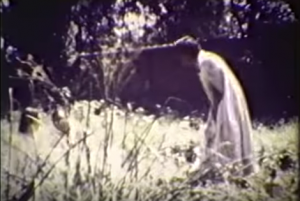
" Ah, verda'? planteaba una extraña combinación entre la militancia política y la contracultural. Jugaba con el ataque a los símbolos del orden nacional y estatal (la bomba en el Monumento a la Revolución y en el PRI, los judiciales persecutores), la crítica a la sociedad de consumo representada por la huida de la pareja de jóvenes entre los espectaculares, la liberación sexual (la combi zarandeada porque dentro hacen el amor, o la urgente calentura de los monjes una vez que han probado el LSD y cruzado las puertas de la percepción), y la representación de la fantasía jipiteca de que el mundo sería más alivianado si todos probaran las drogas duras" (Vázquez Mantecón, 2012).
" Ah, verda' [Ah, right?] was a strange combination between political and countercultural militancy. It played with the attack to symbols of state and national order (a bomb in the Monument to the Revolution and in PRI offices [Revolutionary Institutional Party], the chasing police men), a critique to a consumer society represented by a young couple running away in between billboards, the sexual liberation (a truck shaken because someone is making love inside, the sex desire of monks once they have tried LSD and crossed the gates of perception), and the representation of the mexican hippies' fantasy in which the world would be cooler if everyone tried hard drugs" (Vázquez Mantecón, 2012).
Film about the lives of people in Lorestan, Iran.
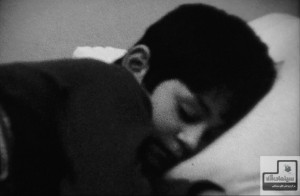
The film follows a group of children living in the same alley. The garbage truck arrives every day disrupting their dreams. The sleepy children are forced to take the garbage out every time and play in the alley after the garbage are taken. The garbage truck stops coming to their alley, allowing them to finally sleep and dream for longer but also results in the neighbours throwing garbage in the alley, stopping the children from playing together.
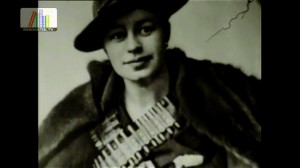
“‘Ben Milyonlarca emekçiden birisiyim barışçıyım ve devrimciyim’ diye başlıyor 12 dakikalık film. Mehmet Özgentürk seslendirmiş. Finlandiyadaki iç savaş ve devrimciler hakkında bilmediğiniz birçok şeyi içinde Enternasyonalin de olduğu Fince marşlar eşliğinde anlatıyor. 1956 yılında gerçekleştirilen 3 hafta süren büyük grevden başlayarak Finlandiya’daki mücadeleyi Nazım şiiri eşliğinde izleyeceksiniz.” Sinematek.tv: http://sinematek.tv/baris-kavgasi/ (30 October 2019).
“The film begins with the sentence, ‘I am one of the millions of workers; I am a pacifist and revolutionist.’ It was narrated by Mehmet Özgentürk. It tells the unknown story of Civil War in Finland and that of Finn revolutionists, synchronized with the local marches. You will watch the Finn revolutionary struggle—since the Great Strike of 1956, lasted 3 weeks—which is accompanied by a Nazım [Hikmet] poem.” Sinematek.tv: http://sinematek.tv/baris-kavgasi/ (30 October 2019).
Total Pages: 299